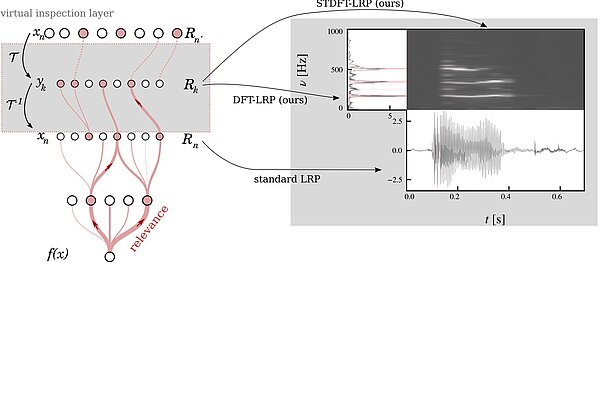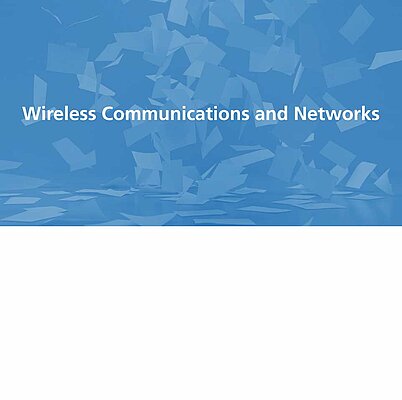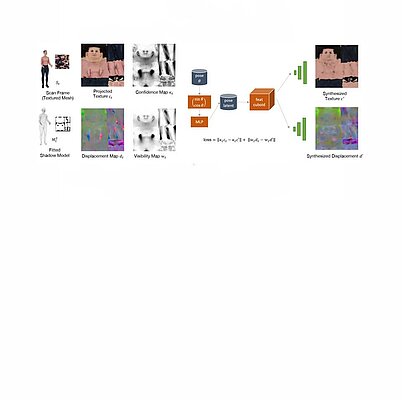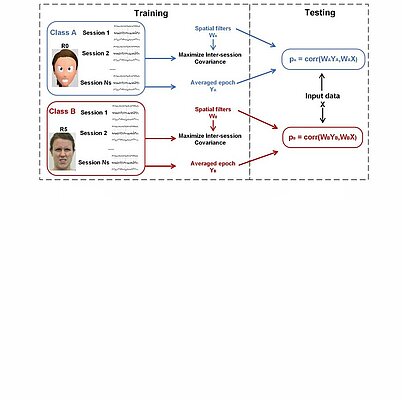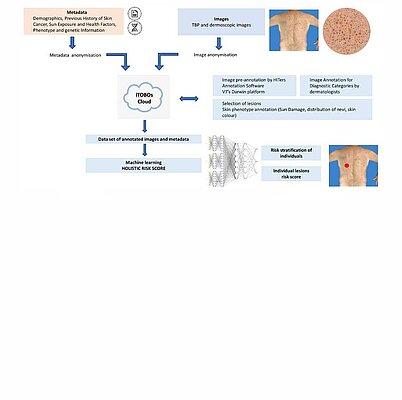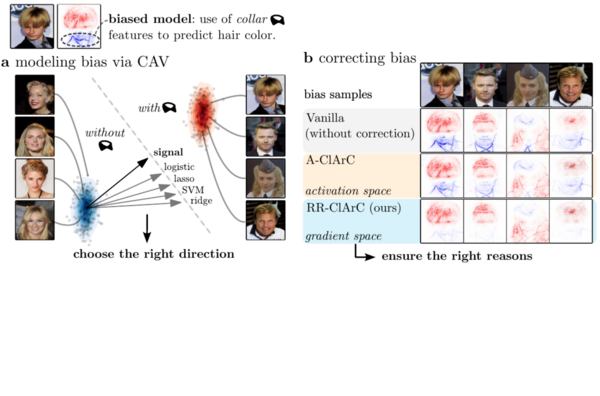First Polymer-based Passive Optical Waveguide for the Visible Range from 633 nm down to 488 nm
We investigated the transmission properties of optical waveguide based on fluorinated acrylate polymer and Ormocer® based polymer in the visible range (VIS). Laser transmission-induced transparency (LTIT) and fluorescence were observed in the...
Model guidance via explanations turns image classifiers into segmentation models
Heatmaps generated on inputs of image classification networks via explainable AI methods have been observed to resemble segmentations of input images in many cases. We apply the "Right for the Right Reason" paradigm of imposing additional losses...
PURE: Turning Polysemantic Neurons Into Pure Features by Identifying Relevant Circuits
Neurons in deep neural networks can act polysemantically, meaning that they encode for multiple (unrelated) features. As such, understanding the inner workings of machine learning models becomes more difficult. We present PURE to turn...
Explainable Concept Mappings of MRI: Revealing the Mechanisms Underlying Deep Learning-Based Brain Disease Classification
While recent studies show high accuracy in the classification of Alzheimer's disease using deep neural networks, the underlying learned concepts have not been investigated. We separated Alzheimer's patients (n=117) from normal controls (n=219) by...
Reactive Model Correction: Mitigating Harm to Task-Relevant Features via Conditional Bias Suppression
DNNs are prone to relying on spurious correlations in data, posing risks in critical applications. Post-hoc methods exist to mitigate this without retraining but can globally shift latent features distributions, harming model performance. We...
AttnLRP: Attention-Aware Layer-wise Relevance Propagation for Transformers
Our new method, AttnLRP, is the first to faithfully and holistically attribute not only input but also latent representations of transformer models with the computational efficiency similar to a single backward pass. We demonstrate that our...
Understanding the (Extra-)Ordinary: Validating Deep Model Decisions with Prototypical Concept-based Explanations
With PCX, we introduce a method that summarizes similar single explanations via prototypical ones. As such, we can understand the whole model behavior quickly and in detail. PCX further allows to validate individual predictions by communicating...
Neuromorphic Wireless Device-Edge Co-Inference via the Directed Information Bottleneck
We consider neuromorphic wireless device-edge co-inference for edge intelligence applications. The directed information bottleneck principle is applied to extract the most relevant information for the task. The model demonstrates superior...
Unlocking the Potential of Local CSI in Cell-Free Networks with Channel Aging and Fronthaul Delays
Centralized or distributed precoding? This is perhaps the most heated debate in the Cell-free Massive MIMO literature. However, in this work we argue that the best option may actually be a mix of the two. The reason is that centralized precoding,...
Si3N4 Microring-Resonator-Based Integrated Photonic Sensor for Enhanced Label-Free Biofluid Analysis in the 850 nm Optical Band
We present an innovative integrated photonic sensor for point-of-care applications using silicon nitride (Si3N4) tailored for biofluids analysis in the 850nm optical band. With microring resonators (MRR) we detect smallest changes in the...
Spot Size Converters for Enhanced Coupling Efficiency Between Single Mode Fibers and High-Confinement Si3N4 Waveguides
For highly loss-sensitive applications of photonic integrated circuits (PICs), efficient coupling of high-confinement silicon nitride (Si3N4) passive waveguides with active optoelectronic components and standard single mode fibers (SMF) is...
Wavelength Tunable, Polymer-Based Arrayed Waveguide Gratings for Hybrid Integration
We present a hybrid integrated photonic circuit with tunable arrayed waveguide gratings (AWGs) as (DE-)MUX stages for optical modulators for use in parallel convolution processing. The simulated and fabricated AWGs have 16 outputs with 500 GHz...
Gaussian Splatting Decoder for 3D-aware Generative Adversarial Networks
We present a novel approach that combines the high rendering quality of NeRF-based 3D-aware GANs with the flexibility and computational advantages of 3DGS. By training a decoder that maps implicit NeRF representations to explicit 3D Gaussian...
Explainable AI for Time Series via Virtual Inspection Layers
For time series data, where the input itself is often not interpretable, dedicated XAI research is scarce. In this work, we put forward a virtual inspection layer for transforming the time series to an interpretable representation and allows to...
Towards Bridging the Gap between Near and Far-Field Characterizations of the Wireless Channel
Exploring near-field propagation is vital for 6G technologies like intelligent reflecting surfaces (IRS). Unlike far-field models, near-field models offer accuracy critical for applications such as beamforming and multiple-access, enhancing...
Optimized Detection with Analog Beamforming for Monostatic Integrated Sensing and Communication
This paper presents an optimization framework for analog beamforming in monostatic integrated sensing and communication (ISAC), which maximizes sensing detection under self-interference cancellation via superiorized projections onto convex...
An integrated 800 Gb/s O-band WDM optical transceiver enabled by hybrid InP-Polymer photonic integration
We propose and demonstrate a novel O-band wavelength division multiplexing (WDM) optical transceiver enabled by the hybrid photonic integration of Indium Phosphide (InP) components into a Polymer based photonic motherboard c! alled PolyBoard. The...
Dynamic Exposure Visualization of Air Quality Data with Augmented Reality
This paper introduces a new concept and outlines the implementation of an AR application designed for mobile devices. It can visualize real-time environmental data from various Open Data platforms. The scientific contribution lies in diverse...
Time-bin entanglement at telecom wavelengths from a hybrid photonic integrated circuit
We present a fiber-pigtailed hybrid photonic circuit comprising nonlinear waveguides for photon-pair generation and a polymer interposer reaching 68 dB of pump suppression and photon separation based on a polarizing beam splitter with > 25 dB...
Towards an AI-enabled Connected Industry: AGV Communication and Sensor Measurement Datasets
We present iV2V and iV2i+, two machine-learning datasets for industrial wireless communication. The datasets cover sidelink and cellular communication involving autonomous robots together with localization and sensing data, which can be used to...
Channel Charting for Beam Management in Sub-THz Systems
Sub-THz communication, vital for 6G, requires densification and multi-connectivity to overcome signal blockage. Efficient beam and user scheduling are crucial. We propose a low-complexity scheduling scheme using machine learning (ML), employing a...
BiSPARCs for Unsourced Random Access in Massive MIMO
This paper addresses the massive MIMO unsourced random access problem in quasi-static Rayleigh fading. Our proposed coding scheme combines an outer LDPC code with an inner SPARC code, integrating channel estimation, single-user decoding, and...
Animatable Virtual Humans: Learning pose-dependent human representations in UV space for interactive performance synthesis
We propose a novel representation of virtual humans for highly realistic real-time animation and rendering in 3D applications. We learn pose dependent appearance and geometry from highly accurate dynamic mesh sequences obtained from...
Realness of face images can be decoded from non-linear modulation of EEG responses
We utilized an EEG dataset of steady-state visual evoked potentials in which participants were presented with human face images of different stylization levels. Assessing neuronal responses, we found a non-linear relationship between SSVEP...
A protocol for annotation of total body photography for machine learning to analyze skin phenotype and lesion classification
AI has proven effective in classifying skin cancers using dermoscopy images. However, clinical application is limited when algorithms are not well-trained, or there is a lack of clinical context (e.g., medical history). The increasing use of...
UL-DL Duality for Cell-Free Massive MIMO With Per-AP Power and Information Constraints
This article advances the theoretical foundations of user-centric cell-free massive MIMO networks. In particular, by means of a novel UL-DL duality principle for fading channels, it settles the optimality of the recently developed “team MMSE”...
Signal separation in radio spectrum using self-attention mechanism
Traditional signal processing methods often fall short compared to data-driven approaches in a signal separation problem that involves co-channel signals, where the energy content of the interference component overlaps with the transmitted signal...
From Hope to Safety: Unlearning Biases of Deep Models via Gradient Penalization in Latent Space
We present a novel method ensuring the right reasons on the concept level by reducing the model's sensitivity towards biases through the gradient. When modeling biases via Concept Activation Vectors, we highlight the importance of choosing robust...
Real-Time Algorithms for Combined eMBB and URLLC Scheduling
This paper investigates efficient scheduling algorithms for coexistence scenarios of devices with different quality of service requirements, such as URLLC and eMBB. It proposes a low-complexity algorithm that outperforms current methods, with...
Predictive Handover Optimization
Future networks aim for higher data rates through cell densification, leading to frequent handovers and increased signaling overhead for moving user equipment (UE). This paper presents an optimization scheme using predicted channel state...













